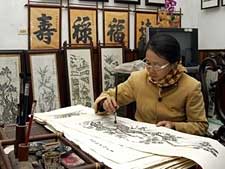A dossier outlining how to make Dong Ho folk woodcut paintings will be prepared for submission to UNESCO for recognition as an intangible cultural heritage in need of urgent safeguarding.
 The information was released on March 7 by Nguyen Thi Hoa, an official from the Bac Ninh Department of Culture, Sports and Tourism.
The information was released on March 7 by Nguyen Thi Hoa, an official from the Bac Ninh Department of Culture, Sports and Tourism.
According to Hoa, the procedures necessary for the compilation of the dossier of the craft, from the northern province of Bac Ninh, commenced in March and the dossier is expected to complete by 2014.
Dong Ho folk woodcut paintings originate from Song Ho commune, Thuan Thanh district.
Traditionally, Dong Ho paintings, which reflect a wide range of themes, especially good luck wishes, historical figures, and folk allegories, were used to decorate homes during the traditional Tet (Lunar New Year) festival.
According to Dong Ho villagers, the craft dates back to the 11th century and the Ly dynasty (1009-1225). However, researchers believe the craft began under the rule of the Le dynasty (1428-1788).
To create the paintings, Dong Ho craftsmen used natural raw materials. They used “do†tree bark to make sheets of printing paper, and created colours from earth, burnt bamboo leaves and sea shells.
The finished painting would be covered with a layer of rice paste to strengthen the durability of its illustration and colours. It was then dried under the sun.
As the traditional craft faded with time, efforts were made to preserve the art. Nguyen Dang Che and Nguyen Huu Sam, two of the few remaining experienced craftsmen in the village, established their own Dong Ho painting centres.
UNESCO recognition is expected to help preserve and raise people’s awareness of the craft’s cultural values.